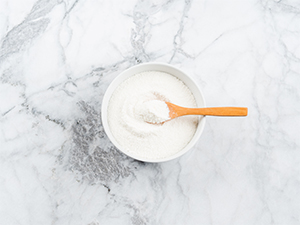
THE SURPRISING USES OF MARBLE
Ingestible Countertop Material?
Most people are familiar with the idea that marble is used for countertops, floors, walls, statues, and decorative items. In the following article from Fred M. Hueston, Chief Technical Director for Surface Care PROS, you’ll discover that marble has many other uses, some of them ingestible! Sit back, relax, and grab some popcorn, because you’re not going to believe what people do with marble.
Garden Lime
Gardeners use lime to raise the pH level of acidic soil, which can help certain plants extract nutrients from the soil. Garden lime is processed from marble. The marble is heated in a kiln, which removes the carbon dioxide from the stone, producing a form of lime called calcium oxide, or quicklime.
Field Marking
In the past, lime was used to mark soccer, baseball, football, and other sports fields. Lime is very caustic, meaning it can cause discomfort or damage if the powder makes its way to a moist skin surface, such as the eyes or sweaty skin of athletes. These days, powdered marble is used as a safer alternative.
Calcium Supplements
Many farm animals require calcium for health reasons and to produce eggs, milk, etc. Farmers mix powdered calcium into animal feed as a supplement. These supplements are nothing more than pulverized marble.
Antacids
If you take an antacid to calm your stomach, you are basically just ingesting powdered marble!
Whiting
Whiting is a fine powder made of marble that is used as a brightener, filler, and even a pigment in many products. It can be used to clean glass after glazing and to shine copper, stainless steel, and other surfaces.
Cosmetics
One of the main ingredients for face powders and blush is pH-neutral calcium carbonate, i.e., marble dust.
Construction Aggregate
Concrete is used for road building and many other uses. Concrete mixtures require cement, water, and an aggregate, such as crushed bits of stone, gravel, or sand. Marble aggregate can be used in concrete.
Neutralizers
Here is a little chemistry lesson. If marble is dissolved in water, it becomes alkaline, which means it increases the pH level of the water. Acid, which is low pH, can be neutralized when marble is added. Marble can be used to increase pH, so it can serve as a neutralizer in swimming pools. It is also used by water treatment plants and other chemical industries.
Your Meds
Many prescription and over the counter drugs use powdered marble as a filler. So the next time you need to take a pill, chances are you will be ingesting some marble.
Paint and Craft Additives
Marble powders are popular in many types of paint, as well as acrylic modeling paste, glue base gesso, and all water and oil dispersed paints.
Carbonated Beverages
Have you ever wondered why there is a tiny explosion when you pop open a can of soda? During the manufacturing process, a can is filled with CO2 dissolved in water. When the can is sealed, the pressure causes a chemical reaction to take place, resulting in carbonic acid. The sound you hear when you open the can is caused by carbonic acid returning to the form of CO2 dissolved in water. The carbonic acid that is used in soda is derived from marble.
Chalk
Sidewalk and blackboard chalk used to be made of marble, but these days, most chalk manufacturers use gypsum.
Marcite and Plasters
Marcite, a sprayed-on coating that is applied to built-in swimming pools, contains marble dust. Many plasters also contain marble dust as their main ingredient.
Groceries
Products containing marble, such as baking powder, toothpaste, dry dessert mixes, dough, and wine, are for sale in your local grocery store. The next time you look at a list of ingredients and you see the word calcium, the product likely contains marble.
Carbon Capture Technology
A study by Industrial & Engineering Chemistry Research reports that one of the most promising technologies to reduce global emissions of carbon dioxide (CO2) is called calcium looping. The process involves scrubbing CO2 from flue gases by using calcium-oxide-based sorbents. You can probably guess what those calcium-oxide-based sorbents are. That’s right. Waste marble powder.
If you ever visit a marble quarry, you will notice a large amount of waste. Thankfully, marble waste is used in many ways.
This article is one of a series of articles written and published on behalf of Surface Care PRO Partners.

